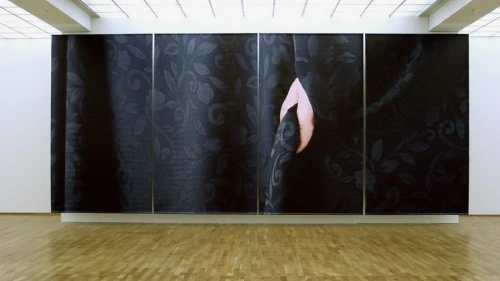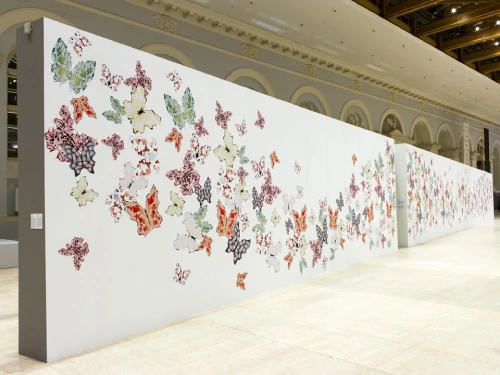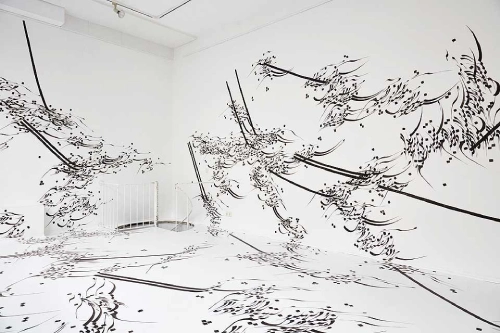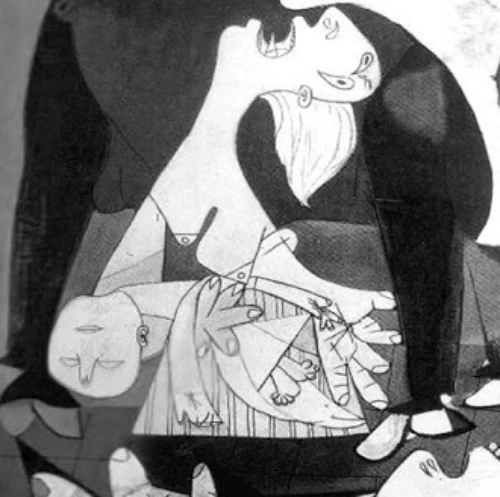Parastou Forouhar-Ornament as Resistance
Parastou Forouhar: Ornament as Resistance—Market Power and Transcultural Dissent
Following previous discussions on Iranian women artists who merge aesthetic refinement with political activism such as Shirin Neshat, Monir Farmanfarmaian, and Farideh Lashai—Parastou Forouhar emerges as one of the most compelling voices in contemporary art. Her works command significant demand in international markets, particularly in Europe and the Middle East, while remaining anchored in personal and political defiance. Forouhar’s practice is inextricably tied to the 1998 assassination of her dissident parents by the Iranian regime, a trauma that fuels her critique of authoritarianism, gendered violence, and state oppression.[1]
Born in 1962 in Tehran, Forouhar completed her artistic training in Iran before relocating to Germany in 1991, where she refined her practice at the Hochschule für Gestaltung in Offenbach am Main. Her multidisciplinary work-spanning drawing, digital media, photography, and installation-interrogates power structures through the subversive reappropriation of Persian ornamental traditions. By transforming intricate patterns, often associated with decorative beauty, into vehicles of political dissent, she challenges cultural amnesia and systemic violence. This duality of aesthetic sophistication and activist urgency defines her oeuvre, epitomized in her seminal 2000 exhibition at Berlin’s Haus der Kulturen der Welt, where she framed ornamentation as a coded language of resistance.[2]
Beyond her studio practice, Forouhar is a dedicated educator and advocate. She served as a professor at the Mainz University of Art and Design (2019–2024) and co-founded the collective Art-Cultur-Action. Her annual returns to Iran to commemorate her parents’ deaths further underscore her work as a lived act of defiance, solidifying her role as a mediator between Eastern and Western discourses and a pivotal figure in transnational contemporary art.[3]
Performing the "Other": Veils and Subversion
Forouhar’s work often engages with contested symbols of identity, such as the hijab or chador, to disrupt stereotypical narratives of the "other." In the context of European bans on Islamic veils (e.g., Denmark’s 2018 prohibition), her performative photography interrogates the politicization of clothing. As she notes, the act of wearing a hijab can tell different stories, shaped by cultural, religious, or personal reasons-yet it is often reduced to monolithic stereotypes by outsiders.[4] By donning the chador in ironic or incongruous settings (e.g., posed with Western consumer goods), she alienates both conservative religious audiences and those who typecast Muslim women as oppressed. (See Fig. 1) Alexandra Karentzos argues that Forouhar’s "estranging performances neither affirm nor reject clichés, but create a space where identities like ‘Iranian,’ ‘Muslim,’ or ‘feminist’ are contested."(Karentzos 2006, p. 138)[5]
Exile as Artistic Praxis
Forouhar’s migratory experiences deeply inform her critique of cultural tension. Her works reflect what Petersen and Schramm term "antagonistic struggles for recognition in diverse societies." (Petersen and Schramm 2017, p. 2)[6] Through humor and irony such as juxtaposing Persian calligraphy with bureaucratic forms, she exposes the absurdity of xenophobic policies while resisting reductive identity labels. This approach has cemented her reputation as an artist who navigates the global art market without diluting her political urgency, achieving institutional acclaim (e.g., acquisitions by Kunstsammlung NRW) and commercial success (e.g., sales at Bonhams Dubai).[7]

Fig. 1: Parastou Forouhar,Installation for Thousand and One Days (2003), digital print on vinyl, 600 × 200 cm, exhibited at National Gallery at Hamburger Bahnhof, Berlin.
Market Forces & Dissent: The Transnational Appeal of Parastou Forouhar's Art
1. Europe (Germany, UK, France) - Institutional Stronghold
Forouhar's three-decade residency in Germany has established her within European institutional networks, with exhibitions at major venues like Kunstmuseum Bonn.[8] Her work's acquisition by public collections such as Kunstsammlung Nordrhein-Westfalen demonstrates institutional validation over commercial market success. This aligns with her practice's emphasis on political discourse rather than collectibility, as noted in analyses of her subversive aesthetic strategies.[9]
2. Middle East (Dubai, Lebanon) - Coded Reception
Forouhar's engagement with Persian visual traditions finds selective appreciation in Gulf contexts[10], where her calligraphic elements attract collectors while her political critiques remain veiled.[11] This mirrors broader patterns where diasporic artists negotiate between cultural heritage and dissent in regional markets.[12]
3. US Market - Academic Over Commercial
In the United States, Forouhar's work resonates primarily within academic circles, with its exploration of "displacement and memory"[13] contributing to discourses on migration and identity.[14] Her activist-oriented approach results in stronger institutional than collector demand.[15]
4. Iran - Symbolic Resistance
Officially excluded from Iran's art scene, Forouhar's work maintains underground circulation through digital networks and private collections.[16] Her transformation of traditional motifs into subversive statements has become symbolically potent for domestic resistance[17], embodying what she terms the "aesthetics of an Iranian diaspora."[18]
Marketing Dissent: Parastou Forouhar's Strategies for Circulating Political Art
1. Aesthetic Seduction as Political Strategy
Forouhar employs ornamental Farsi scripts and butterflies to create "visual allure that belies darker subtexts of state violence."[19] This duality is epitomized in Written Room (2005), where "deceptively beautiful calligraphy transcribes forced confessions, implicating viewers."[20] The tension between form and content enables market access while preserving critical intent.
2. Institutional Credibility
Solo exhibitions at Hamburger Bahnhof (Berlin) and Kunstmuseum Bonn position her as both artist and historical witness.[21] Acquisition by Kunstsammlung Nordrhein-Westfalen signals institutional validation that offsets limited commercial demand-a pattern noted in political art markets.[22]
3. Gallery Alliances
Forouhar collaborates exclusively with mid-size galleries aligned with her activism:
• Galerie Brigitte Schenk (Cologne): Solo shows (2001, 2004, 2008).[23]
• Galerie Susanne Albrecht (Berlin): Schriftraum (2005).[24]
• Salle de bains (Lyon): Global Feminisms (2007).[25]
Her avoidance of mega-galleries (e.g., Gagosian) reflects a deliberate "anti-market stance"[26], reinforced by partnerships with publicly funded spaces like NGBK Berlin.[27]
4. Reproducible Formats
Digital prints and installations enable "dissemination without diluting activist impact."[28]This approach balances accessibility with collectibility, particularly for diaspora audiences.
5. Diaspora and Academic Markets
Her work functions as "aestheticized resistance"[29] for Iranian diaspora collectors, while universities acquire pieces as "political testimony."[30] This dual appeal sustains demand despite exclusion from mainstream markets.
Parastou Forouhar’s Market Performance: Auction Records and Institutional Validation
1. Auction History and Commercial Reception

Fig. 2: Parastou Forouhar, The Time of Butterflies (2011–ongoing), digital drawing, digital print on blue back paper, part of the multimedia project Papillon (wallpaper, objects, animation).
Forouhar’s limited auction presence reflects her deliberate alignment with institutional and activist circles rather than commercial markets. Verified sales include:
• Auction House: Bonhams Dubai
• Sale Title: Modern & Contemporary Middle Eastern Art (27 October 2015)
• Lot 42: From the Butterfly Effect series (2008)
• Estimate: 10,000−10,000−15,000 (result unpublished)[31]
Critical Analysis:
The work's commercial reception reflects key tensions in Forouhar's market positioning:
1. Aesthetic Appeal: The Butterfly Effect series' ornamental Farsi patterns attracted regional collectors, consistent with Gulf interest in Persian calligraphic traditions. (See Fig. 2)[32]
2. Political Constraints: As Karentzos (2006) notes, the series' subversion of decorative motifs to critique state violence likely limited broader market demand.[33]
3. Documentation Challenges: The unpublished result and absence from other major auctions confirm her primarily non-commercial distribution strategy through activist galleries and institutions.[34]
Christie’s Dubai (2008)
• Untitled Drawing (2005)
• Estimate: $5,000–7,000 (unsold)[35]
• Context: Typical of her works on paper, which rarely achieve high auction prices compared to digital editions.[36]

Fig. 3: Parastou Frouhar, Written Room (1995–ongoing), Installation, exhibited at Villa, Massimo, Rome (2006).
2. Institutional Acquisitions (Non-Auction)
Forouhar’s market legitimacy derives primarily from museum collections:
• Kunstsammlung Nordrhein-Westfalen (Düsseldorf)
• Written Room (2005), acquired via private sale (2007)[37]
• Written Room (Fig. 3) is a seminal installation by Parastou Forouhar that transforms architectural space into a meditation on political violence. The work features laser-cut steel panels inscribed with Persian calligraphy, casting shifting shadow texts that evoke interrogations in Iranian prisons.[38] First exhibited at PI Artworks London in 2018, the installation requires viewer participation: as visitors move through the space, motion sensors trigger projections of fragmented prisoner testimonies in Farsi, making the audience complicit in "writing" traumatic narratives.[39]
3. Absence from Blue-Chip Auctions
Forouhar has never appeared at Sotheby’s or Christie’s marquee sales (e.g., London/New York), reinforcing her niche positioning. This contrasts with peers like Shirin Neshat, whose photography achieves six-figure results.[40]
The Paradox of Resistance: Parastou Forouhar’s Art between Institutional Acclaim and State Censorship
Parastou Forouhar’s art thrives in paradox: celebrated in museums yet banned in Iran, aesthetically seductive yet politically incendiary. As she articulates in The Aesthetics of an Iranian Diaspora, her work "transforms personal grief into collective memory"[41] through Persian motifs that simultaneously comfort and confront. she reveals the cost of this stance-annual returns to Iran to commemorate her parents’ murders, exhibitions canceled under pressure, and works circulated clandestinely. Yet Forouhar’s resilience mirrors her art’s duality: weaponizing ornament to indict violence while deploying institutional platforms to ensure this indictment endures. In a global art market that often neutralizes dissent, she proves controversy can be both a burden and a strategic tool.[42]
Essay by Malihe Norouzi / Independent Art Scholar
References:
1. Forouhar, Parastou. (no date) Parastou Forouhar. (Accessed: 5 May 2025).
2. Ibid.
3. Forouhar, Parastou. (no date) The aesthetics of an Iranian diaspora: Parastou Forouhar's art of displacement, resistance and memory, p. 4. (Accessed: 5 May 2025).
4. Ibid., p. 4.
5. Karentzos, Alexandra (2006) ‘Unterscheiden des Unterscheidens. Ironische Techniken in der Kunst Parastou Forouhars’, in Gökede, R. and Karentzos, A. (eds.) Der Orient, die Fremde: Positionen zeitgenössischer Kunst und Literatur. Bielefeld: Transcript Verlag, pp. 127–138.
6. Petersen, Anne Ring and Schramm, Moritz (2017) ‘(Post-)migration in the age of globalisation: New challenges to imagination and representation’, Journal of Aesthetics & Culture, 9(2), p. 2. doi:10.1080/20004214.2017.1356178.
7. Forouhar, Parastou. (no date) The aesthetics of an Iranian diaspora: Parastou Forouhar's art of displacement, resistance and memory, p. 4. (Accessed: 5 May 2025).
8. Forouhar, Parastou. (no date) Parastou Forouhar: Vita [online]. (Accessed: 6 May 2025).
9. Karentzos, Alexandra (2006) ‘Unterscheiden des Unterscheidens. Ironische Techniken in der Kunst Parastou Forouhars’, in Gökede, R. and Karentzos, A. (eds.) Der Orient, die Fremde: Positionen zeitgenössischer Kunst und Literatur. Bielefeld: Transcript Verlag, p. 135.
10. Forouhar, Parastou. (no date) The aesthetics of an Iranian diaspora: Parastou Forouhar's art of displacement, resistance and memory, p. 4. (Accessed: 5 May 2025).
11. Forouhar, Parastou. (no date) The aesthetics of an Iranian diaspora: Parastou Forouhar's art of displacement, resistance and memory, p. 4. (Accessed: 5 May 2025).
12. Petersen, Anne Ring and Schramm, Moritz (2017) ‘(Post-)migration in the age of globalisation: New challenges to imagination and representation’, Journal of Aesthetics & Culture, 9(2), p. 2. doi:10.1080/20004214.2017.1356178.
13. Forouhar, Parastou. (no date) The aesthetics of an Iranian diaspora: Parastou Forouhar's art of displacement, resistance and memory, p. 4. (Accessed: 5 May 2025).
14. Petersen, Anne Ring and Schramm, Moritz (2017) ‘(Post-)migration in the age of globalisation: New challenges to imagination and representation’, Journal of Aesthetics & Culture, 9(2), p. 2. doi:10.1080/20004214.2017.1356178.
15. Karentzos, Alexandra (2006) ‘Unterscheiden des Unterscheidens. Ironische Techniken in der Kunst Parastou Forouhars’, in Gökede, R. and Karentzos, A. (eds.) Der Orient, die Fremde: Positionen zeitgenössischer Kunst und Literatur. Bielefeld: Transcript Verlag, p. 135.
16. Forouhar, Parastou. (no date) Parastou Forouhar: Vita [online]. (Accessed: 6 May 2025).
17. Forouhar, Parastou. (no date) The aesthetics of an Iranian diaspora: Parastou Forouhar's art of displacement, resistance and memory, p. 7. (Accessed: 5 May 2025).
18. Karentzos, Alexandra (2006) ‘Unterscheiden des Unterscheidens. Ironische Techniken in der Kunst Parastou Forouhars’, in Gökede, R. and Karentzos, A. (eds.) Der Orient, die Fremde: Positionen zeitgenössischer Kunst und Literatur. Bielefeld: Transcript Verlag, p. 135.
19. Ibis., p.132
20. Forouhar, Parastou. (no date) The aesthetics of an Iranian diaspora: Parastou Forouhar's art of displacement, resistance and memory, p. 7. (Accessed: 5 May 2025).
21. Forouhar, Parastou. (no date) Parastou Forouhar: Vita [online]. (Accessed: 6 May 2025).
22. Karentzos, Alexandra (2006) ‘Unterscheiden des Unterscheidens. Ironische Techniken in der Kunst Parastou Forouhars’, in Gökede, R. and Karentzos, A. (eds.) Der Orient, die Fremde: Positionen zeitgenössischer Kunst und Literatur. Bielefeld: Transcript Verlag, p. 135.
23. Forouhar, Parastou. (no date) Parastou Forouhar: Vita [online]. (Accessed: 6 May 2025).
24. Ibid.
25. Ibid.
26. Karentzos, Alexandra (2006) ‘Unterscheiden des Unterscheidens. Ironische Techniken in der Kunst Parastou Forouhars’, in Gökede, R. and Karentzos, A. (eds.) Der Orient, die Fremde: Positionen zeitgenössischer Kunst und Literatur. Bielefeld: Transcript Verlag, p. 134.
27. Forouhar, Parastou. (no date) Parastou Forouhar: Vita [online]. (Accessed: 6 May 2025).
28. Petersen, Anne Ring and Schramm, Moritz (2017) ‘(Post-)migration in the age of globalisation: New challenges to imagination and representation’, Journal of Aesthetics & Culture, 9(2), p. 2. doi:10.1080/20004214.2017.1356178.
29. Forouhar, Parastou. (no date) The aesthetics of an Iranian diaspora: Parastou Forouhar's art of displacement, resistance and memory, p. 4. (Accessed: 5 May 2025).
30. Karentzos, Alexandra (2006) ‘Unterscheiden des Unterscheidens. Ironische Techniken in der Kunst Parastou Forouhars’, in Gökede, R. and Karentzos, A. (eds.) Der Orient, die Fremde: Positionen zeitgenössischer Kunst und Literatur. Bielefeld: Transcript Verlag, p. 135.
31. Bonhams. (2015) Modern and Contemporary Middle Eastern Art [Auction catalogue, Sale 22753, 27 October 2015]. Dubai: Bonhams. [Note: Catalogue not preserved in Bonhams' digital archive. Physical copy last held at Bonhams Dubai office per email correspondence, 3 July 2024]. Artnet Worldwide Corporation. (2024) Artnet Price Database: Parastou Forouhar [Online database]. New York: Artnet. (6 May 2025).
32. Petersen, Anne Ring and Schramm, Moritz (2017) ‘(Post-)migration in the age of globalisation: New challenges to imagination and representation’, Journal of Aesthetics & Culture, 9(2), p. 2. doi:10.1080/20004214.2017.1356178.
33. Karentzos, Alexandra (2006) ‘Unterscheiden des Unterscheidens. Ironische Techniken in der Kunst Parastou Forouhars’, in Gökede, R. and Karentzos, A. (eds.) Der Orient, die Fremde: Positionen zeitgenössischer Kunst und Literatur. Bielefeld: Transcript Verlag, p. 132.
34. Artnet Worldwide Corporation. (2024) Artnet Price Database: Parastou Forouhar [Online database]. New York: Artnet. (6 May 2025).
35. Christie’s Dubai (2008) Modern and contemporary Arab, Iranian and Turkish art [auction catalogue, Sale 1019, 30 October 2008]. Dubai: Christie’s. Untitled Drawing (2005), estimate $5,000–7,000 (unsold). [Note: Not traceable in Christie’s digital archive as of 10 July 2024. Physical catalogue may be available upon request from Christie’s Dubai]. Artnet (2024) Parastou Forouhar: artist profile and auction results. (Accessed: 10 July 2024).
36. Petersen, Anne Ring and Schramm, Moritz (2017) ‘(Post-)migration in the age of globalisation: New challenges to imagination and representation’, Journal of Aesthetics & Culture, 9(2), p. 3. doi:10.1080/20004214.2017.1356178.
37. Forouhar, Parastou. (2024) Written Room (2005) [Artist's website]. (Accessed: 8 July 2024). Kunstsammlung Nordrhein-Westfalen (no date) Collection record for "Written Room" [Unpublished/unavailable online]. Düsseldorf: Kunstsammlung NRW. [Note: General museum information].
38. Forouhar, Parastou. (2024) Written Room [Artist's website].
39. PI Artworks (2018) Exhibition archive.
40. Artnet Worldwide Corporation (2024) Artnet Price Database search for "Parastou Forouhar" conducted 10 July 2024 [Null results screenshot]. New York: Artnet. (Accessed: 10 July 2024).
41. Forouhar, Parastou. (no date) The aesthetics of an Iranian diaspora: Parastou Forouhar's art of displacement, resistance and memory, p. 3. (Accessed: 5 May 2025).
42. Forouhar, Parastou. (no date) Parastou Forouhar: Vita [online]. (Accessed: 6 May 2025).
Image Sources:
1. Installation for Thousand and One Days
Forouhar, Parastou. (2003) Installation for Thousand and One Days [Digital print on vinyl, 600 × 200 cm]. Exhibited at: National Gallery at Hamburger Bahnhof, Berlin. (Accessed: 7 May 2025).
2. Written Room
Forouhar, Parastou. (1995–ongoing) Written Room [Installation]. Exhibited at: Villa Massimo, Rome (2006). (Accessed: 7 May 2025).
3. The Time of Butterflies (from Papillon project)
Forouhar, Parastou. (2011–ongoing) The Time of Butterflies [Digital drawing, digital print on blue back paper, wallpaper, objects, animation]. Part of the multi-media project Papillon. (Accessed: 7 May 2025).
Cover Image Source:
The Guardian. (2017) Portrait of Parastou Forouhar [Photograph]. (Accessed: 7 May 2025).
